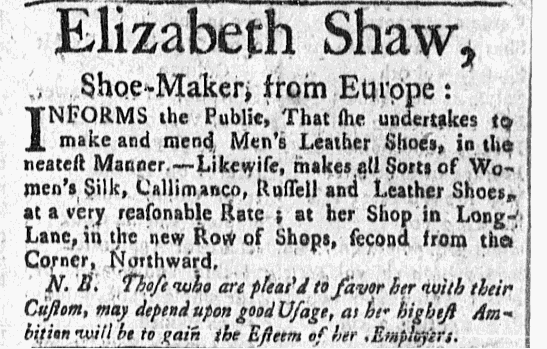June 22, 1767 Boston Post-Boy, This post is from The Adverts 250 Project which is conducted by Carl Robert Keyes, professor of history at Assumption University in Worcester, Massachusetts. Students from Colonial America, Revolutionary America, Research Methods, & Public History courses at Assumption University serve as guest curators for the Adverts 250 Project.
Elizabeth Shaw, 18C Boston Shoemaker

“She undertakes to make and mend Men’s Leather Shoes.”
Elizabeth Shaw, “Shoe-Maker, from Europe,” was not the only woman who placed a newspaper advertisement for consumer goods and services in a colonial newspaper 250 years ago on this day. Mary Hill also inserted a commercial notice in the Boston Post-Boy, informing potential customers that she sold a “Variety of Millinary.” Priscilla Manning informed readers of the Boston Evening-Post that she carried a “Variety of English & India GOODS” at her shop. In other colonies, Mary Maylem’s advertisement for a “neat Assortment of fashionable GOODS” appeared in the Newport Mercury. The Widow Hays hawked “ALL Sorts of PICKLES … with several Sorts of SWEET MEATS” in the New-York Gazette while Margaret Collins and Elizabeth Bevan each placed her own advertisement for “Gentlemen Lodgers” in the New-York Mercury. Mrs. Adams did not place a separate advertisement in the South Carolina Gazette, but writing master William Adams indicated near the end of his notice that “Mrs. Adams will teach young ladies to sew” and planned to acquire “a compleat assortment of millinary” to retail on her own.
Shaw joined the ranks of other women who entered the marketplace by inserting an advertisement in the public prints, but the nature of her business differed from the other women who advertised on the same day. Among those who sold goods, Manning and Maylem operated shops where they sold all kinds of imported goods, but especially textiles and housewares. Hill specialized in selling millinery and also made her own hats to sell to other women. Hays provided food to her customers. Collins, Bevan, and Adams extended their domestic responsibilities into business endeavors, the first two taking in boarders and Adams teaching girls to sew. Although they all entered the marketplace, these women followed occupations deemed appropriate to their gender. Shaw, on the other hand, practiced a trade more often associated with men, though not their exclusive domain. She did not limit herself to predominantly female clients, but instead made and repaired “Men’s Leather Shoes” as well. The other female advertisers demonstrated what was probable when it came to women’s occupations in colonial America, but Shaw’s advertisement testified to what was possible.